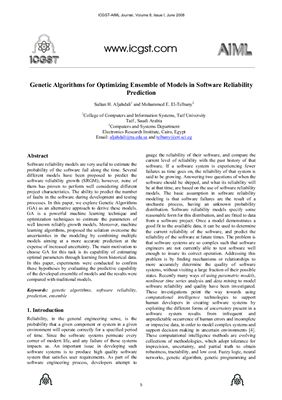Article
Software reliability models are very useful to estimate the probability of the software fail along the time. Several different models have been proposed to predict the
software reliability growth (SRGM); however, none of them has proven to perform well considering different project characteristics. The ability to predict the number of faults in the software during development and testing processes. In this paper, we explore Genetic Algorithms
(GA) as an alteative approach to derive these models.
GA is a powerful machine leaing technique and optimization techniques to estimate the parameters of well known reliably growth models. Moreover, machine
leaing algorithms, proposed the solution overcome the uncertainties in the modeling by combining multiple models aiming at a more accurate prediction at the
expense of increased uncertainty. The main motivation to choose GA for this task is its capability of estimating optimal parameters through leaing from historical data.
In this paper, experiments were conducted to confirm these hypotheses by evaluating the predictive capability of the developed ensemble of models and the results were
compared with traditional models.
Software reliability models are very useful to estimate the probability of the software fail along the time. Several different models have been proposed to predict the
software reliability growth (SRGM); however, none of them has proven to perform well considering different project characteristics. The ability to predict the number of faults in the software during development and testing processes. In this paper, we explore Genetic Algorithms
(GA) as an alteative approach to derive these models.
GA is a powerful machine leaing technique and optimization techniques to estimate the parameters of well known reliably growth models. Moreover, machine
leaing algorithms, proposed the solution overcome the uncertainties in the modeling by combining multiple models aiming at a more accurate prediction at the
expense of increased uncertainty. The main motivation to choose GA for this task is its capability of estimating optimal parameters through leaing from historical data.
In this paper, experiments were conducted to confirm these hypotheses by evaluating the predictive capability of the developed ensemble of models and the results were
compared with traditional models.

